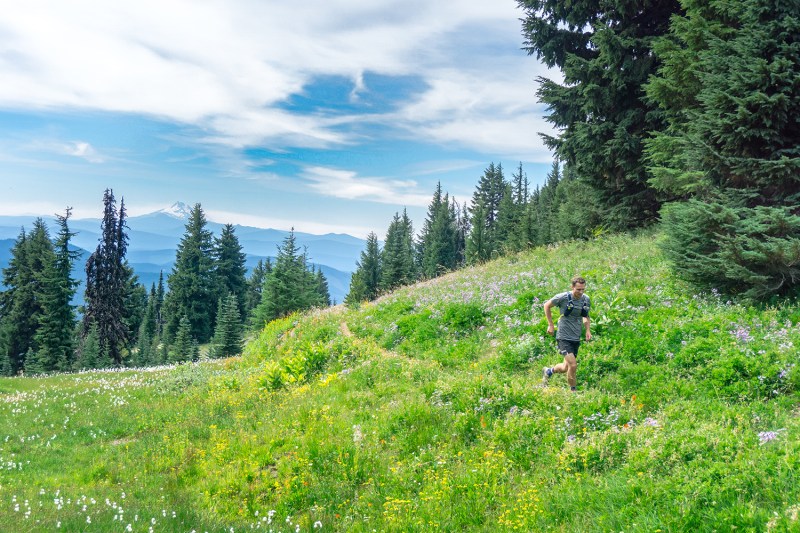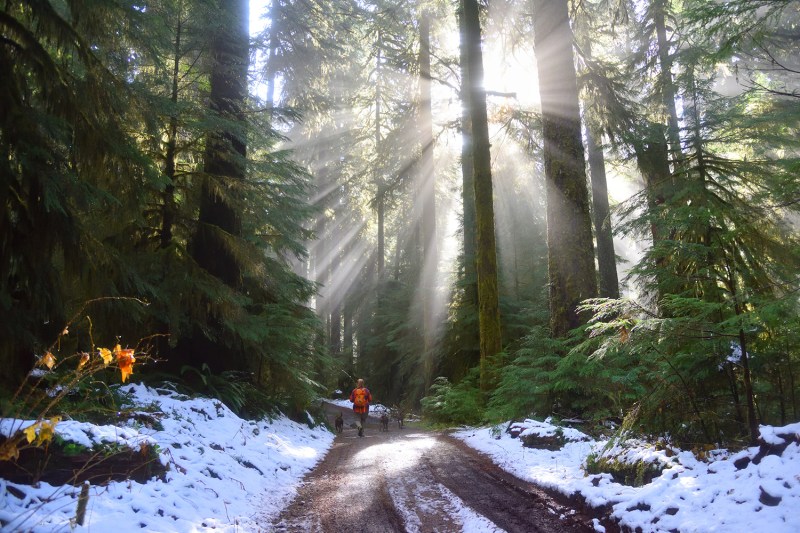Even if you’re not a very outdoorsy person, you’ve probably heard of trail running. It’s a pastime that’s becoming more and more popular as people look to spend more time outside in nature while also getting in a healthy workout. If you’re interested in seeing if trail running is a good fit for you, here’s a great beginner’s guide to introduce you to this unique sport and teach you everything you need to know to become a trail runner. When you’re ready to get started, put on your best trail running shoes and keep your feet steady.
What is Trail Running?
As the name suggests, trail running is a type of running that takes place outdoors, usually on wilderness trails. Generally, trail running involves more changes in elevation (with ascents and descents) and diverse terrain than road running, practiced on unpaved, gravel, or dirt tracks.

Is Trail Running Difficult?
It depends on the type of trail you’re running on, but generally yes, due to the alternating terrain and obstacles, trail running is more difficult than road running. This is why it’s important to take your time easing into this sport. Even if you’re an experienced runner, for your first trail runs you should start on flatter, better-groomed trails so you get accustomed to the difference in feel and difficulty from the running that you’re used to. After you’ve gotten into the swing of things, you can branch out to other trails that have more changes in elevation and aren’t as groomed or maintained, and may have obstacles like rocks, roots, uneven surfaces, and sharp changes in elevation. As you practice and run more, your stamina will improve.
How Do You Train for Trail Running?
Trail running is a whole different animal from road running in terms of form and physicality. In road running, you’d usually use longer strides to cover more ground faster, but in trail running, to maintain balance and traction with the uneven ground, you’ll want to practice taking shorter strides that keep your feet under your body. You should also swing your arms more to help with your balance.
Lots of people get into road running because they can zone out during the run, but that’s definitely something you shouldn’t do in trail running. Because of the terrain and the presence of more obstacles, you should always be aware of your surroundings and keep your eyes on the trail ahead of you instead of on your feet so you can more quickly react. It can be tempting to admire the wilderness you’re running through, but please only do so during breaks.

It’s also important to remember that, due to the varied terrain and the presence of more unpredictable elements and obstacles, it may take you longer to complete a run than it normally would. This is totally normal because trail running is a whole different ballgame, so don’t get discouraged if it takes a while to get into the swing of things and build up your stamina and endurance.
What are the Benefits of Trail Running?
There are tons of benefits to trail running, some of which are similar to those of road running and others that are related to being outside and the uniqueness of the sport.
Due to the rough terrain, trail running is especially beneficial for strengthening the legs; it also engages more muscles in your core, feet, and ankles, making it great for improving your running game overall, either on pavement or on the trail. It improves stamina, endurance, and balance, and is easier on your knees and legs since you’re not impacting hard asphalt or concrete. And since you’re tackling more difficult terrain, generally you will burn more calories and have a more dynamic workout than road running.
But it’s mainly the many mental and emotional benefits that draw people to the sport. Being outside in nature, enjoying the fresh air, and getting away from city life are known to reduce anxiety, stress, and depression, improving mental health and positivity. So, if you’re looking to give your brain as good a workout as your body, trail running could be just the thing.
What Gear Do You Need?
As with road running, the most important gear for trail running is your shoes. Not just any kind of runners will do because you’re going to be running on difficult terrain, so for your comfort and safety, it’s worthwhile to invest in a good pair of trail running shoes.
Trail runners are usually designed lower to the ground, offer better protection for the feet, and have unique lugs for better grip. Lots of top athletic wear companies like Nike and Adidas make trail runners, as well as smaller, more specialized retailers like On and Arc’teryx. Choosing the right kind of trail runners for you also depends on the type of terrain you’re likely to be running on. For beginners, groomed trails with less elevation and fewer obstacles (like rocks, roots, etc.) are recommended as you gain experience and stamina. For these types of trails, you could usually start with your normal running shoes before finding trail runners.

Then, when you’re ready to tackle more technically difficult trails with obstacles and elevation, you’ll want a shoe with a well-padded outsole (the outside part of the shoe that comes into contact with the ground) that offers protection of both the heel and toes, with treads and lugs that provide grip and traction against rugged terrain, wet, muddy, or snowy dirt, and unstable footing.
It’s also extremely important that you take extra good care of your trail runners, washing them frequently and ensuring that they dry properly.
Apart from shoes, you’ll also need moisture-wicking runner’s apparel (leggings, shorts, pants, shirts, socks, etc.), layers to take off or add on depending on the weather and time of day (hoodies, jackets, etc.), sunglasses, a hat, sunscreen, a reusable water bottle, first aid, headlamp (if running in the early morning or evening), and, if you’re in unfamiliar territory, navigation tools.
When is the Best Time to Go Trail Running?
Since it’s practiced outdoors, lots of trail runners usually do it in warmer weather (spring, summer, and fall), or on good weather days during winter. But lots of participants don’t let bad weather, rain, or snow stop them and will go trail running in any season or weather. However that’s only recommended if you’ve been trail running for a while and have some experience, so don’t head out after a fresh snowfall for your first trail run!
Where Can You Go Trail Running?
Anywhere there are trails outside! Outdoorsy, nature-loving places like Oregon, Washington, Colorado, northern California, Montana, Wyoming, Vermont, and other states with ample mountains, forests, and even deserts usually have strong trail-running communities and many different trails to try. Some of the most popular cities and towns for trail runners include Bend, Oregon; Santa Fe, New Mexico; Boulder, Colorado; Moab, Utah; and Middlebury, Vermont.

But even if you live in urban areas, there could still be trail running opportunities around or near you, either close to the city or in urban parks. New York City, which most people would assume to be the exact antithesis of a good trail running area, actually has several great parks for trail running, like Inwood Hill Park. So just because you’re a city-dweller doesn’t mean you can’t become a regular trail runner.
There are also different kinds of trails you can use. If you’re looking for an easier run, wider and better-groomed trails in popular hiking or outdoorsy areas are good places to start. But when you’re ready to up the ante, seek out singletrack trails (so-called because they’re commonly used by mountain bikers and are about the width of a bike) that will present more challenges in the form of obstacles, uneven terrain, and elevation gains or losses.
You can also use resources like Trail Run Project, All Trails, and Trail Runner Magazine to look up trails in your area.
What Else Do I Need to Know?
There are a few other things to keep in mind when it comes to trail running. You’ll need to consider your personal safety in the outdoors. Instead of simply heading to the gym or going for a run around the neighborhood, you’ll be heading out into the wilderness, so be sure that someone knows where you’re going, leave a note, or have your cell phone on you. You should also bring along water and first aid. Finally, always be aware of your surroundings and research what to do in case of a wild animal attack or encounter. Wild animal attacks are extremely rare, but sometimes they do happen because the animal interprets the runner as prey, so it’s best to be prepared and know what to do in the worst scenario.
Also, one of the main reasons people become trail runners is for a love of the outdoors: They want to spend more time enjoying nature. That means that they follow trail etiquette and Leave No Trace principles by respecting the rules of the trail, respecting other runners, hikers, and outdoorsmen, staying on the path, yielding to runners headed uphill, and never littering. If you’re unfamiliar with the tenets of Leave No Trace, it’s a good idea to research them before heading out.
Why Should I Try Trail Running?
You may be asking yourself: If I can just go running at the gym, why should I invest the time and energy it would take to head out of town, find a suitable trail, and then do a run that’s much more difficult and time-consuming?
Many people find trail running to be more rewarding than road running; you’re outdoors, in the fresh air, and surrounded by nature. It’s a more immersive and empowering experience, with an almost primal attraction because you’re running through the wilderness like early humans once did. Lots of runners also enjoy the new challenges and rewards that trail running presents, with many saying that it’s helped them tackle mental health issues like depression and anxiety. Some have even described it as transformative.
Trail running clearly has a dedicated and loyal fan club that firmly believes in its benefits. So why not give it a go? Find a local trail, lace up those shoes, and start running!



